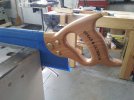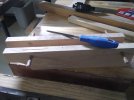So, watching all the videos, many claim for small crosscuts their standard rip tenon saw is fine. Well, I was trying to do some mitered bridle joints in 3 inch table top edges, and I found even my good Crown saw to be a bit rough. I want a true crosscut.
LN, Cosman, Veritas... Big bucks
Vintage, have not located yet, but open to a deep one.
So I bought an S&J "tenon saw" off Amazon. Cheap, but said to be good steel. Folded brass back etc. Terrible handle. It does not say what the tooth pattern is, other than 15 TPI.
As expected it is RIP, but surprise, a WAVY set. I guess that is what makes it a combo and a little cleaner crosscut than a strait rip.
But I want a true crosscut.
Step one: Make a new saw vice as I bought a vintage iron Stanley and can't find it anywhere!
Step two: Over to the anvil and remove all the set. I think I got it good enough. Still dead strait.
Step three: Make a shim for my saw set to reduce the normal set. It went to "10" and I think that is too much for a joinery saw. #6 brass washer I honed flat on a course diamond stone flat and a tad thinner.
Step four: Re-file the teeth. I got started and pretty easy, but taking a break. Hard to see even through my lighted magnifier lamp.
Next will be to de-bur, do the set and test/tune. Lastly will be to fix the handle.
Of course this will take me all day and just buying a good saw is smarter if all I wanted was a saw, but I figure by the time I get this one dialed in, I will be a pro at fine tooth saws. I can do pretty well on my 5, 8 and 10.
PS:
Following WEB advice, I reduced the rake on the first two inches of my RIP and sure enough, it is far easier to start.
LN, Cosman, Veritas... Big bucks
Vintage, have not located yet, but open to a deep one.
So I bought an S&J "tenon saw" off Amazon. Cheap, but said to be good steel. Folded brass back etc. Terrible handle. It does not say what the tooth pattern is, other than 15 TPI.
As expected it is RIP, but surprise, a WAVY set. I guess that is what makes it a combo and a little cleaner crosscut than a strait rip.
But I want a true crosscut.
Step one: Make a new saw vice as I bought a vintage iron Stanley and can't find it anywhere!
Step two: Over to the anvil and remove all the set. I think I got it good enough. Still dead strait.
Step three: Make a shim for my saw set to reduce the normal set. It went to "10" and I think that is too much for a joinery saw. #6 brass washer I honed flat on a course diamond stone flat and a tad thinner.
Step four: Re-file the teeth. I got started and pretty easy, but taking a break. Hard to see even through my lighted magnifier lamp.
Next will be to de-bur, do the set and test/tune. Lastly will be to fix the handle.
Of course this will take me all day and just buying a good saw is smarter if all I wanted was a saw, but I figure by the time I get this one dialed in, I will be a pro at fine tooth saws. I can do pretty well on my 5, 8 and 10.
PS:
Following WEB advice, I reduced the rake on the first two inches of my RIP and sure enough, it is far easier to start.


